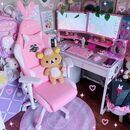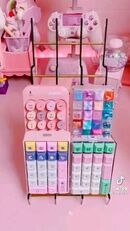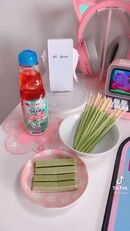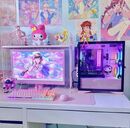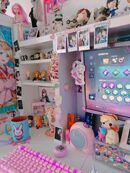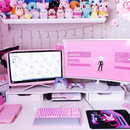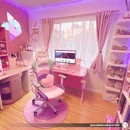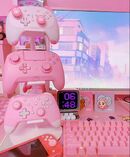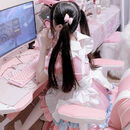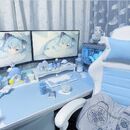Kawaii Gamer, aka Pastel E-Girl, is a westernized version of Kawaii that is popular amongst gamers, Twitch streamers, and anime fans. The Kawaii Gamer community gathers on Twitch frequently and tends to be Gen Z. This differs from other forms of Kawaii in that it contains specific merchandise, room decor, and fashion trends that are more aligned with the Western interpretation of Kawaii, as opposed to actual Japanese Kawaii fashions. showing increased globalization as anime and games reach a larger audience. The objects common in the aesthetic are incredibly replicated, and the aesthetic is shown in TikToks that are dedicated to showing the set-ups of a kawaii gamer. While the aesthetic requires a large quantity of merchandise (as maximalism is common), it is more accessible and casual than actual J-fashion due to the rise of Kawaii culture globally and the increased e-commerce and commercialization of media properties. Kawaii Gamer Girl fashion is highly inspired by the Erokawa, Babygirl, Soft Girl, and Neko aesthetics.
Some women in this aesthetic put on the persona of a "gamer girl," where they advertise their love for video games, have a cute physical appearance, and bubbly personality through making TikTok videos and content on Twitch and YouTube. There are also some women who incorporate this aesthetic into their sexual presentation, as the Babygirl aesthetics evolve and grow more popular. Others focus exclusively on room decor/electronics, unboxing merchandise, and collecting inspiration and do not show themselves on camera.
These people, typically women, are expressing their femininity and love for these certain characters in a hobby that is traditionally dominated by men and male aesthetics. For example, most gaming merch is in black and red with aggressively sleek detailing, which isn't palatable for many girls. Kawaii gaming aesthetics would thus allow women interested in video gaming to have their own community where they do not have to sacrifice their femininity for their hobbies.
Some kawaii gamers also focus on breaking the idea of there being a difference between "real" games and "casual" games, as many people (especially men) believe that more action and competition-driven games are superior to ones with lower stakes.
History[]
One notable influence on this aesthetic is the E-Girl, who was also influenced by Kawaii culture but involved more black. Scene culture, and even some sexual imagery inspired the more mature types of Kawaii gamer. Some make-up and fashion trends, such as tennis skirts, heavy blush, and long dyed hair (often in wigs), influenced the outward appearance and gender performance of a kawaii gamer.
Visuals[]
The aesthetic can take on an either Yume Kawaii palette of pastels and white, rainbow, or more purple and blue neon, which allows for many color variations on the aesthetic.
Of course, kawaii gamers tend to show their love for both their passions through combining the two. Technology for gaming in pink and white accents, such as PCs, Nintendo DS, and Switches are the most shown photo subject and is most representative of this interpretation of kawaii. Customized keyboards with decorative keys in multiple colors are one of the entry points into the aesthetic due to their accessibility and variety of models and key caps, such as glowing lights, paw prints, and different colors and fonts for the display.
Displays on computer home pages and social media are also important to the aesthetic. Admirers of the aesthetic customize backgrounds of PCs, mouse pads, social media icons and headers, and phone lock screens to fan art of their favorite characters, kawaii art, abstract drawings in pastels, etc.
Certain products are iconic and highly sought-after in this community. One of them being the Autofull pink gaming chair with attached bunny ears and a tail, which was popularized by Twitch streamers and gaming YouTubers.[1] Another are cat-ear headphones, which are an example of connecting the Erokawa trope of the anime catgirl with technology.
Building off on the inclusion of catgirls, anime girls and women who display cuteness are extremely popular, especially Nezuko Kamado from Demon Slayer, Sailor Moon, and Chika Fujiwara from Kaguya-sama: Love Is War. This also includes VOCALOID characters such as Hatsune Miku.
In addition to anime characters, mascots are constantly replicated in merchandise created by popular franchises such as Sanrio and Pokémon. Plushies, themed snacks, mouse pads, stationery, etc. of characters such as Pikachu, My Melody, and Hello Kitty clutter the desks of many kawaii enthusiasts, and having affection for a certain mascot is encouraged.
These figurines and plushies are often purchased from subscription boxes, with a comment video format in the community being people opening these products. Similarly, many videos feature Japanese snack openings, where the person on TikTok uploads a video where they arrange Pocky, KitKat, candies, etc. on a platter from either a subscription box or a haul to an Asian grocery store. Boba and Japanese soda is also popular. Many of these are themed after a certain flavor, such as strawberry or matcha.
For wall decor, a common thing that differentiates this aesthetic from other Kawaii ones is the use of LED or neon lights in pink or purple tubing. This is a general trend in Gen Z gaming and TikTok communities, but with kawaii shapes such as sakura blossoms or bunny silhouettes.
Sakura motifs are also common in general, as it is connected with Japan and is often featured in anime.
All of these visuals culminate in set-ups, which are the main mode of carrying across the aesthetic. A set-up is the desk space of a gamer and the place where they watch anime, do work, eat snacks, etc. This is why the set-up is the most prioritized place in the aesthetic, as a kawaii gamer would spend most of their time there. The desk would include the electronics, multiple figurines and plushies, walls with lighting and posters, and snacks in a cluttered, yet cozy arrangement that requires a large amount of things.
Activities[]
The aesthetic is communicated through multiple different TikTok formulas. Some of them include:
- Set-up tours where the OP shows the set-up and zooms into certain things
- Arranging set-ups where OP places things on shelves; build chairs, shelves, carts, etc.; and decorates their space
- Asian beverage/snack shopping, subscription box opening, and arranging on colored plates
- Customizing keyboards and PCs
- Opening figurines and other merchandise
- Showing listings on Amazon to show viewers where to get certain products
Media[]
This section describes the media that Kawaii Gamers interact with, rather than there being this type of aesthetic within the media. The following below contains content mainly from Japan.
Manga & Anime[]
- My Hero Academia (2016)
- My Dress-Up Darling (2022)
- Darling in the FranXx (2018)
- Kaguya-sama: Love Is War (2019)
- Spy × Family (2022)
- Demon Slayer: Kimetsu no Yaiba (2019)
- Kakegurui – Compulsive Gambler (2017)
- Sailor Moon (1991)
- Rascal Does Not Dream of Bunny Girl Senpai (2018)
- Attack on Titan (2013)
- Himouto! Umaru-chan (2013)
Video Games[]
- Animal Crossing franchise (2001-present)
- Osu! (2007)
- Overwatch (2016)
- Genshin Impact (2020)
- League of Legends (2009)
- Kirby franchise (1992-present)
- Among Us (2018)
- Fall Guys (2020)
- Pokémon franchise (1996-present)
Characters[]
- Chiaki Nanami (Danganronpa 2)
- Chika Fujiwara (Kaguya-sama: Love Is War)
- Chocola (Nekopara)
- D.Va (Overwatch)
- Some Project Sekai characters (Emu Otori, Nene Kusanagi, Ena Shinonome, Mizuki Akiyama, Kanade Yoisaki, etc.)
- Futaba Sakura (Persona 5)
- Genshin Impact girls (Mona, Ganyu, Raiden Shogun, Yae Miko, etc.)
- Hatsune Miku (VOCALOID)
- Kirby (Nintendo)
- Llenn/Karen Kohiruimaki (Sword Art Online)
- Lucky Chloe (Tekken)
- Madoka Kaname (Puella Magi Madoka Magica)
- Mai Sakurajima (Rascal Does Not Dream Of Bunny Girl Senpai)
- Marin Kitagawa (My Dress-Up Darling)
- Mitsuri Kanroji and Nezuko Kamado (Demon Slayer: Kimetsu no Yaiba)
- Nagatoro (Ijiranaide, Nagatoro-san)
- Pokémon characters (Pikachu, Eevee, Snorlax, Jigglypuff, etc.)
- Runa Yomozuki (Kakegurui – Compulsive Gambler)
- Sagiri Izumi (Eromanga Sensei)
- Saiko Yonebayashi (Tokyo Ghoul)
- Sanrio characters (most popular are Kuromi, My Melody, Hello Kitty, Cinnamoroll, etc.)
- Shiro (No Game, No Life)
- Super Sonico
- Umaru (Himouto! Umaru-chan)
- Usagi Tsukino (Sailor Moon)
- Yoshino Himekawa (Date A Live)
- Zero Two (Darling in the FranXx)
YouTubers and Streamers[]
This section includes female content creators who have this aesthetic. VTubers, which are real people who use anime avatars instead of showing their face, are also included.
- Belle Delphine
- Laurenzside
- Pokimane
- SSSniperWolf
- Neekolul
- Hannah OwO
- Nintendo.Grl
- Jookstogo
- kettletoro
- OhhMyKawaii
Music[]
The music associated with the aesthetic tends to be in the VOCALOID, video game soundtrack, chiptune, Otacore and kawaii Lo-fi genres. These are often cheerful sounding, with electronic beats and sound clips of extremely feminine-voiced women exclaiming something in Japanese.
In addition, some people who admire this aesthetic may be connected with Hallyu and be K-Pop fans.
Criticism[]
This section is under construction
Men can objectify gamer girls and focus on the persona of their kawaii aesthetic and appearance. Many memes express wanting to have these women as girlfriends to fawn over. Another criticism of Kawaii Gamer may involve the fetishization of East-Asian cultures, which reduces it to an extremely sexualized and commercialized image. This includes stuff like sexualized school uniforms. Many Kawaii Gamers also "Asianfish", where a person of another race or ethnicity wears make-up and in some cases, even undergo cosmetic surgery, to look "East-Asian". They typically exhibit infantilizing mannerisms (such as puffing out cheeks, having almond shaped eyes, etc.) and perpetuate stereotypes of East-Asian women being seen as "childlike and submissive". Sometimes, people will even make this aesthetic their whole personality.
Gallery[]

